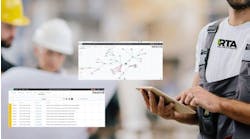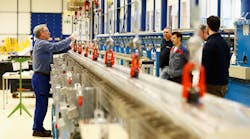Scroll to the bottom for a quick safety checklist.
Facility and building regulations vary across industries, but all facility managers are responsible for prioritizing safety for building occupants and assets.
Tailored safety strategies are crucial to meet the unique needs of each facility. However, there are a few general guidelines managers can follow to improve the security of their facilities. Consider applying the tips outlined below to ensure you provide the best protection for your facility and occupants year-round.
The Basics
Foundational security and safety for facilities require more than just video surveillance. Begin by initiating security policies for your building, such as requiring employees to wear ID badges or carry access cards on site. These policies provide opportunities for all building occupants to support safety and security strategies.
As a facility or safety manager, you are responsible for ensuring your security systems function properly and comply with local laws and safety codes. Regularly testing your security, fire, and life safety systems can confirm system functionality for both emergency scenarios and for everyday operations. These checks can also identify opportunities for better energy usage, improving the efficiency of your facility as well as building security.
Additionally, consulting with a security provider can offer new ideas for safety policies and strategies. These security professionals can share information on new regulatory and code requirements and ensure compliance with updated standards while also identifying holes in existing security systems and strategies that might be overlooked.
Systems Integration
Once the initial pieces of your security strategy are in place, consider taking your facility's safety and everyday operations to the next level through systems integration. When coupled with foundational facility safety strategies, systems integration can improve efficiencies and reduce costs while also strengthening your building security as your safety and security systems communicate and operate with additional facility systems.
Systems integration is quickly becoming one of the top priorities for facility managers. The Energy Efficiency Indicator (EEI) survey by Johnson Controls found investment in building system integration increased 36% in 2020 compared to 2019. And one-third of respondents (33%) plan to invest in the integration of building technology systems with distributed energy resources in the next year, a 15% increase over 2020.
Remote monitoring is one example of how systems integration ensures facility protection.
For instance, when implemented in a school, remote monitoring uses video surveillance systems throughout the hallways and classrooms connected with sensors and access control systems at key entry points to identify suspicious activity, such as an unknown visitor entering the building or an at-risk individual engaging in potentially harmful activities. The system then alerts school security personnel who can remotely check the situation 24/7 and determine the best course of action more quickly and efficiently.
This reduces nuisance alarms, cutting back on the costs associated with those alarms and building relationships of trust between the school, security personnel, and local emergency responders.
Predictive maintenance of integrated systems should also play a significant role in your building safety strategies. Not only does this reduce potential risks, but predictive maintenance can reduce system downtime and energy usage. For example, sensors throughout a healthcare facility can identify rising temperatures in patient rooms or burst pipes within the building’s HVAC systems. Each of these presents significant risks to the building and its patients and physicians.
Updating lighting systems is another way to significantly improve facility safety strategies as well as building efficiency. Connecting LED lighting with occupancy sensors creates an integrated system that not only reduces energy use in unoccupied areas but also provides improved visual acuity within the facility, maximizing the visibility of existing video surveillance cameras.
The immediate security of your facility and its occupants should always be your top priority, but improved building efficiency can be a productive side effect of implementing these security strategies.
Emergency Preparedness
System integrations also are critical in emergency situations, not just everyday operations. Facility and safety managers must have emergency preparedness plans in place for hazardous situations and understand how to prevent those circumstances.
The majority of respondents, 81% said that increasing the flexibility of facilities to quickly respond to a variety of emergency conditions was very or extremely important driver of investment. Protecting the health and safety of building occupants during emergency situations followed closely after with 76%.
In geographic areas where inclement weather or natural disasters are more common, specific plans should be discussed and set in place to further ensure facility and occupant safety.
Having an emergency preparedness drill in place, along with a schedule for those drills, allows building occupants to be aware of procedures and possible warning signs. These drills can then mitigate incidents and panic in the middle of an actual emergency response situation.
Communications play a vital role in emergency situations. Combining communications with existing facility systems should also be a part of your building safety strategy. For example, mass notification and emergency communication systems can be connected with fire detection systems, light sensors, and HVAC sensors.
These integrations then allow occupants to be visually or verbally directed to safe locations while simultaneously alerting emergency response teams, creating faster reaction times both inside and outside the building.
Facility Safety Moving Forward
Maintaining and improving your facility's safety requires proactive planning and action. Systems integration will continue to play an increasingly vital role in these safety strategies as more facility managers prioritize investing in these systems to ensure the security of facility occupants and assets.
Emergency preparedness plans, ensuring efficient operations, and maintaining foundational security systems combined with these systems will all contribute to strengthening your facility's safety strategy.
Reassess your existing safety and security programs while identifying year-round plans to implement these best practices. Instituting these security policies enhances the awareness of building occupants to potential safety risks, keeping security as a top-of-mind priority for everyone in the facility.














